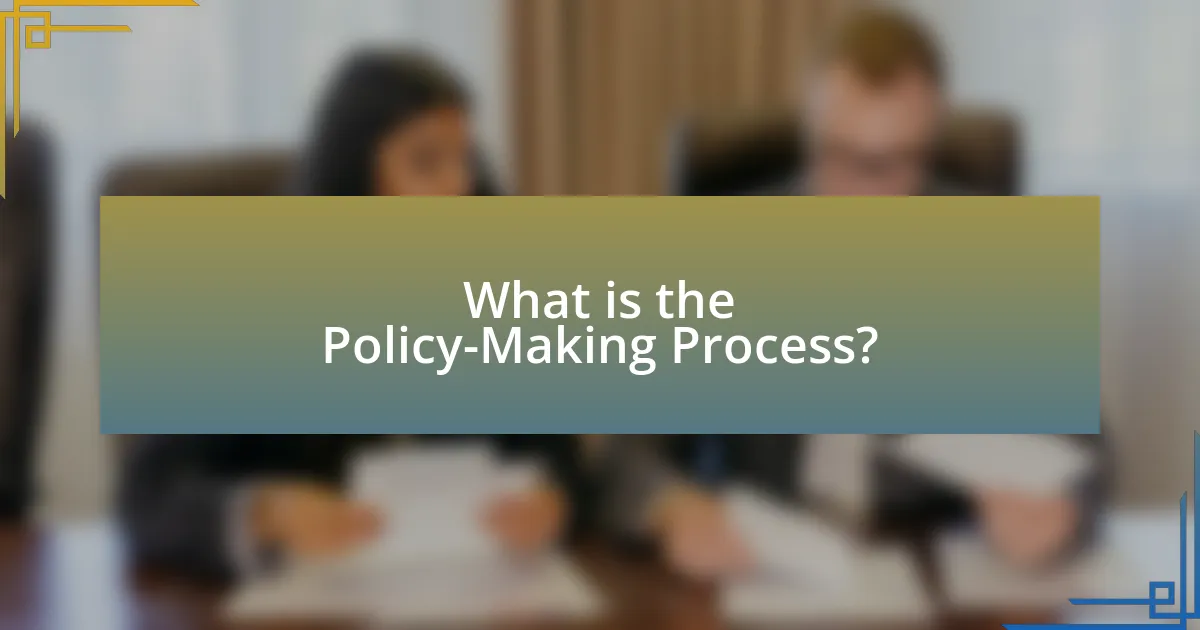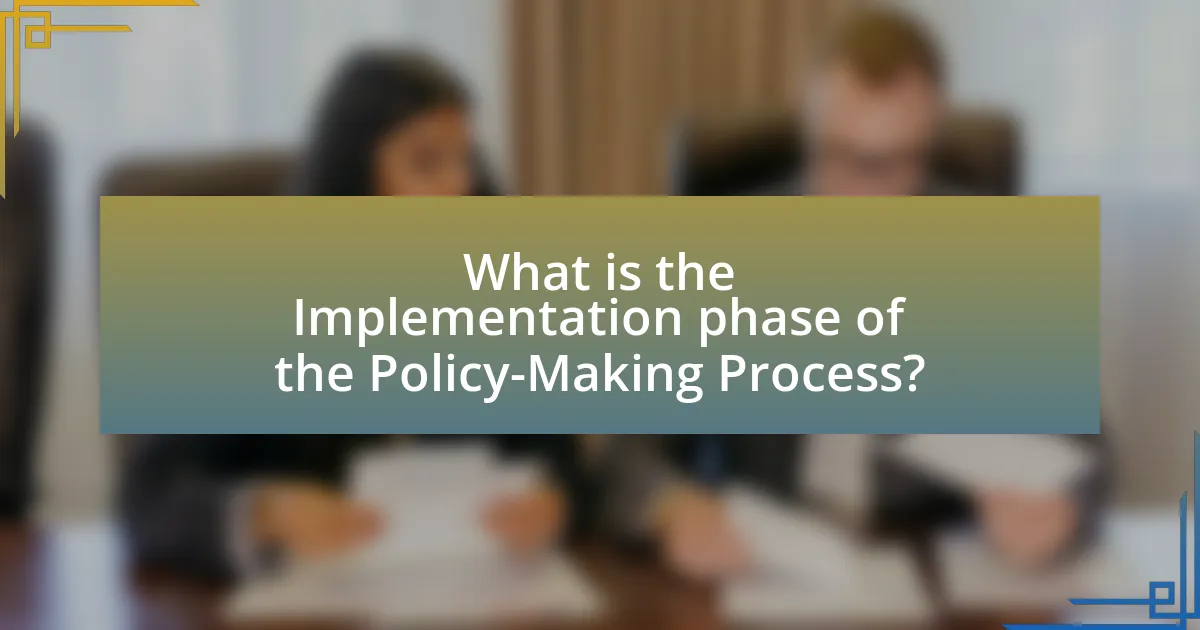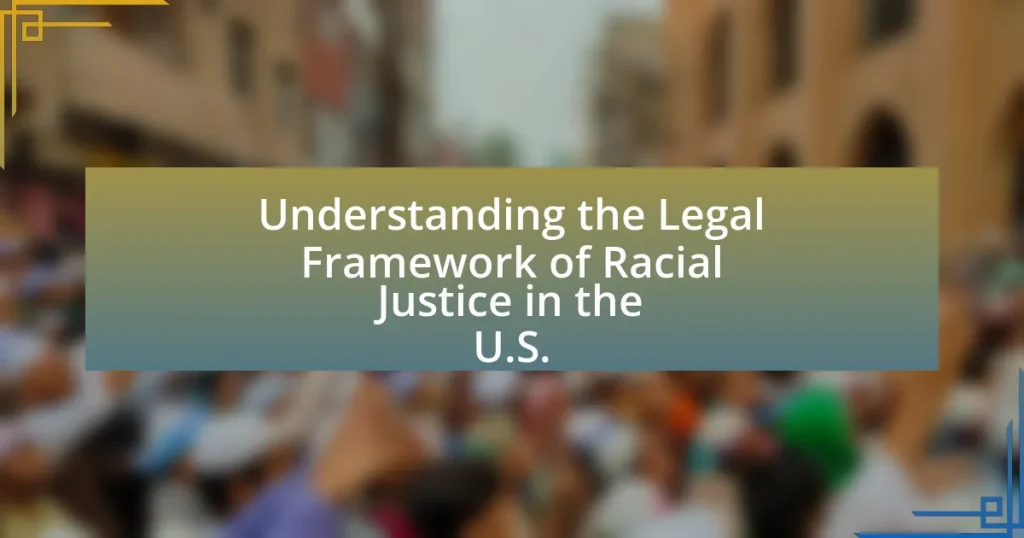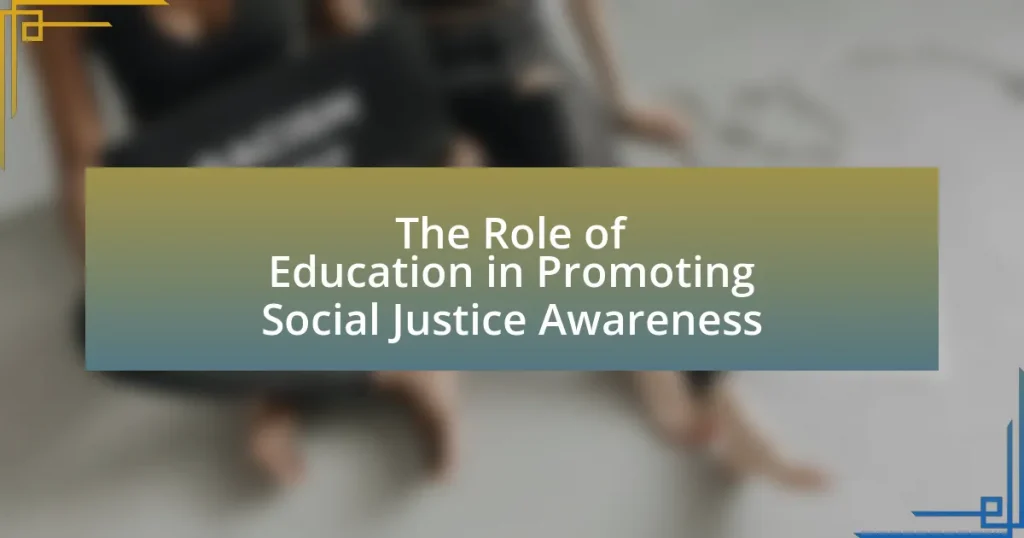The article focuses on the policy-making process, detailing the systematic steps that governments and organizations undertake to create and implement policies. It outlines key stages including agenda setting, policy formulation, decision-making, implementation, and evaluation, emphasizing the importance of stakeholder engagement and evidence-based analysis. The article further explores the factors influencing policy decisions, such as political, economic, and social elements, and highlights the critical role of public participation and stakeholder involvement in shaping effective policies. Additionally, it discusses the challenges faced during implementation and the best practices for ensuring successful policy outcomes.

What is the Policy-Making Process?
The policy-making process is a systematic series of steps that governments and organizations follow to create and implement policies. This process typically includes agenda setting, policy formulation, decision-making, implementation, and evaluation. For instance, the agenda-setting phase identifies issues that require government attention, while policy formulation involves developing specific proposals to address those issues. According to the National Academy of Public Administration, effective policy-making requires stakeholder engagement and evidence-based analysis to ensure that the resulting policies are relevant and effective.
How does the Policy-Making Process begin?
The policy-making process begins with agenda setting, where issues are identified and prioritized for governmental action. This initial stage involves recognizing problems that require attention, often influenced by public opinion, interest groups, or political leaders. For instance, the 1964 Civil Rights Act emerged from a national agenda that highlighted racial discrimination, demonstrating how societal concerns can propel issues onto the policy agenda.
What are the stages involved in the Policy-Making Process?
The stages involved in the Policy-Making Process are agenda setting, policy formulation, policy adoption, policy implementation, and policy evaluation. Agenda setting identifies issues that require government attention, while policy formulation develops specific proposals to address these issues. Policy adoption involves the decision-making process where policies are officially approved. Policy implementation is the execution of the adopted policies, and policy evaluation assesses the effectiveness and impact of the policies. Each stage is critical for ensuring that policies are relevant, effective, and responsive to societal needs.
Why is understanding the Policy-Making Process important?
Understanding the policy-making process is important because it enables stakeholders to effectively influence and navigate the development and implementation of policies. This understanding allows individuals and organizations to identify key stages such as agenda setting, formulation, adoption, implementation, and evaluation, which are critical for successful advocacy and engagement. For instance, research by Kingdon (1995) in “Agendas, Alternatives, and Public Policies” highlights how recognizing the interplay of problems, policies, and politics can lead to more effective participation in the policy process. Therefore, grasping the nuances of policy-making equips stakeholders with the tools necessary to advocate for their interests and contribute to informed decision-making.
What factors influence the Policy-Making Process?
The factors that influence the policy-making process include political, economic, social, and institutional elements. Political factors encompass the interests and power dynamics of various stakeholders, including government officials, political parties, and interest groups, which shape the agenda and priorities of policy decisions. Economic factors involve the availability of resources, budget constraints, and economic conditions that can dictate the feasibility and scope of policies. Social factors, such as public opinion, cultural values, and demographic trends, play a crucial role in determining the acceptability and support for policies. Institutional factors refer to the structures and rules within which policy-making occurs, including legal frameworks, bureaucratic processes, and the roles of various governmental and non-governmental organizations. These factors collectively interact to shape the formulation, adoption, and implementation of policies, as evidenced by historical examples like the Affordable Care Act in the United States, where political negotiations and public opinion significantly influenced the outcome.
How do political, social, and economic factors shape policy decisions?
Political, social, and economic factors significantly shape policy decisions by influencing the priorities and actions of policymakers. Political factors, such as party ideology and electoral pressures, determine which issues are prioritized on the policy agenda. For instance, a government led by a progressive party may focus on social welfare policies, while a conservative administration might prioritize tax cuts. Social factors, including public opinion and demographic trends, affect policymakers’ responsiveness to societal needs; for example, increasing public concern about climate change has led to more robust environmental policies. Economic factors, such as budget constraints and economic conditions, directly impact the feasibility of policy proposals; during economic downturns, governments may prioritize austerity measures over expansive social programs. Historical examples, such as the New Deal in the 1930s, illustrate how economic crises can lead to significant shifts in policy direction, driven by the interplay of these factors.
What role do stakeholders play in the Policy-Making Process?
Stakeholders play a crucial role in the policy-making process by influencing decisions, shaping agendas, and providing essential information. They include individuals, groups, or organizations that have an interest in the outcome of a policy, such as government agencies, non-profits, businesses, and the public. Their involvement can affect the formulation, adoption, and implementation of policies, as they bring diverse perspectives and expertise that can enhance the quality of decision-making. For example, stakeholder consultations often lead to more informed policies that reflect the needs and concerns of the community, thereby increasing public support and compliance.

What is Agenda Setting in the Policy-Making Process?
Agenda setting in the policy-making process refers to the stage where issues are identified and prioritized for governmental attention and action. This process is crucial as it determines which topics will be discussed and potentially addressed by policymakers. Research indicates that agenda setting is influenced by various factors, including public opinion, media coverage, and interest group advocacy, which collectively shape the political landscape and highlight specific issues. For instance, the 2016 U.S. presidential election demonstrated how media framing can elevate certain topics, such as immigration and healthcare, onto the national agenda, thereby influencing policy discussions and decisions.
How does Agenda Setting impact the Policy-Making Process?
Agenda setting significantly impacts the policy-making process by determining which issues receive public and governmental attention. This process influences the prioritization of topics, shaping the agenda that policymakers consider for action. For instance, research by Kingdon (1995) in “Agendas, Alternatives, and Public Policies” illustrates how issues gain prominence through media coverage and public discourse, leading to their inclusion in the policy agenda. Consequently, the agenda-setting phase can dictate the direction of policy development, as issues that are highlighted are more likely to be addressed by legislators and government officials.
What criteria determine which issues are prioritized in Agenda Setting?
The criteria that determine which issues are prioritized in Agenda Setting include public salience, political feasibility, and the ability to garner media attention. Public salience refers to the importance of an issue to the general public, which influences policymakers to prioritize issues that resonate with constituents. Political feasibility assesses whether an issue can realistically be addressed given the current political climate and available resources. Media attention plays a crucial role as issues that receive significant coverage are more likely to be recognized and prioritized by decision-makers. These criteria collectively shape the agenda by highlighting issues that are urgent, actionable, and visible to both the public and policymakers.
How do media and public opinion influence Agenda Setting?
Media and public opinion significantly influence agenda setting by determining which issues receive attention and priority in public discourse. The media acts as a gatekeeper, selecting and framing news stories that shape public perception and awareness. For instance, studies have shown that when the media extensively covers specific topics, such as climate change or healthcare, these issues become more salient in the minds of the public and policymakers. Public opinion, in turn, can pressure decision-makers to prioritize these issues, as elected officials often respond to the concerns and preferences of their constituents. Research by McCombs and Shaw in 1972 demonstrated that the media’s focus on certain topics directly correlates with the public’s perception of their importance, illustrating the reciprocal relationship between media coverage and public opinion in the agenda-setting process.
What are the key players involved in Agenda Setting?
The key players involved in Agenda Setting include policymakers, media, interest groups, and the public. Policymakers, such as government officials and legislators, prioritize issues based on their importance and feasibility. The media plays a crucial role by highlighting specific topics, influencing public perception and urgency. Interest groups advocate for particular issues, seeking to sway policymakers and public opinion. Lastly, the public’s concerns and demands can shape the agenda by prompting policymakers to address specific issues. These interactions among the players determine which issues gain prominence in the policy-making process.
Who are the policymakers and what roles do they play?
Policymakers are individuals or groups responsible for creating, implementing, and evaluating public policies. They include elected officials, government agencies, and various stakeholders such as interest groups and non-governmental organizations. Elected officials, such as legislators and executives, play a crucial role in setting the policy agenda, proposing legislation, and making decisions that affect public welfare. Government agencies implement policies through regulations and programs, while interest groups advocate for specific issues, influencing policymakers through lobbying and public campaigns. The effectiveness of policymakers is often measured by their ability to address societal needs and respond to public opinion, as evidenced by the passage of significant legislation like the Affordable Care Act, which aimed to expand healthcare access in the United States.
How do interest groups and advocacy organizations affect Agenda Setting?
Interest groups and advocacy organizations significantly influence agenda setting by shaping public discourse and prioritizing specific issues. They achieve this through lobbying efforts, mobilizing grassroots support, and utilizing media campaigns to highlight their concerns. For instance, the National Rifle Association (NRA) effectively promotes gun rights by consistently framing the narrative around Second Amendment protections, thereby ensuring that gun control remains a contentious topic in political discussions. Research indicates that interest groups can sway policymakers by providing information, resources, and public support, which can lead to the inclusion of their issues on the legislative agenda.

How does the Policy Formulation stage work?
The Policy Formulation stage involves the development of specific policy proposals based on identified issues and objectives. During this stage, policymakers analyze data, consult stakeholders, and consider various alternatives to address the problems outlined in the agenda-setting phase. This process often includes drafting policy options, assessing their feasibility, and evaluating potential impacts, which can be informed by empirical evidence and expert opinions. For instance, the formulation of healthcare policies may involve reviewing health statistics and consulting medical professionals to create effective solutions.
What are the methods used in Policy Formulation?
The methods used in policy formulation include analytical methods, participatory methods, and comparative methods. Analytical methods involve data analysis and modeling to assess the potential impacts of policy options, while participatory methods engage stakeholders in the decision-making process to gather diverse perspectives and insights. Comparative methods analyze existing policies in different contexts to identify best practices and lessons learned. These methods are essential for creating effective and evidence-based policies that address societal needs.
How do research and analysis contribute to effective Policy Formulation?
Research and analysis are critical to effective policy formulation as they provide evidence-based insights that inform decision-making. By systematically gathering data and evaluating existing policies, researchers identify the needs and priorities of the population, which helps policymakers understand the context and implications of their choices. For instance, a study by the National Academy of Sciences found that data-driven policy decisions lead to improved outcomes in public health initiatives, demonstrating that empirical evidence can significantly enhance the effectiveness of policies. Furthermore, analysis of various policy alternatives allows for a comparative assessment of potential impacts, costs, and benefits, ensuring that policymakers can choose the most effective strategies to address societal issues.
What are the common challenges faced during Policy Formulation?
Common challenges faced during policy formulation include conflicting stakeholder interests, limited resources, and insufficient data. Conflicting stakeholder interests can lead to disagreements on policy objectives, making consensus difficult. Limited resources, such as funding and personnel, can hinder the development and implementation of effective policies. Insufficient data affects the ability to make informed decisions, as policymakers may lack the necessary information to assess the potential impacts of proposed policies. These challenges are well-documented in studies on public policy, highlighting the complexities involved in creating effective and inclusive policies.
What role does public participation play in Policy Formulation?
Public participation plays a crucial role in policy formulation by ensuring that diverse perspectives and needs are considered in the decision-making process. Engaging the public allows policymakers to gather valuable insights, identify community priorities, and enhance the legitimacy of policies. Research indicates that policies developed with public input are more likely to be effective and widely accepted, as they reflect the actual needs and preferences of the population. For instance, a study by the International Association for Public Participation found that public involvement can lead to better policy outcomes and increased trust in government institutions.
How can citizen engagement improve policy outcomes?
Citizen engagement can improve policy outcomes by ensuring that policies reflect the needs and preferences of the community. When citizens actively participate in the policy-making process, they provide valuable insights and feedback that can lead to more effective and relevant policies. Research shows that policies developed with citizen input are more likely to gain public support and compliance, as they address the actual concerns of the population. For instance, a study by the National Academy of Public Administration found that citizen engagement in local governance leads to increased trust in government and better service delivery, demonstrating a direct correlation between engagement and positive policy outcomes.
What are the best practices for facilitating public input?
The best practices for facilitating public input include creating accessible platforms for engagement, ensuring transparency in the process, and actively soliciting diverse perspectives. Accessible platforms, such as online surveys and public forums, allow a wider audience to participate, which is essential for gathering comprehensive feedback. Transparency fosters trust and encourages participation, as stakeholders are more likely to engage when they understand how their input will be used. Actively soliciting diverse perspectives ensures that the input reflects the views of various community segments, which can lead to more equitable and effective policy outcomes. Research indicates that inclusive public engagement can enhance the legitimacy of policy decisions and improve community satisfaction with governance.

What is the Implementation phase of the Policy-Making Process?
The Implementation phase of the Policy-Making Process is the stage where policies are put into action through the execution of plans and allocation of resources. During this phase, government agencies and organizations carry out the directives established in the policy formulation stage, translating theoretical frameworks into practical applications. Successful implementation often requires coordination among various stakeholders, adherence to timelines, and the establishment of monitoring mechanisms to assess effectiveness. Research indicates that effective implementation can significantly influence policy outcomes, as seen in studies such as “The Implementation of Public Policy” by Sabatier and Mazmanian, which highlights the importance of factors like clarity of goals and the commitment of implementing agencies.
How is a policy implemented once it is formulated?
A policy is implemented once it is formulated through a series of structured steps that include planning, resource allocation, and execution. The implementation process typically begins with the establishment of a clear action plan that outlines specific objectives, timelines, and responsibilities. This is followed by mobilizing necessary resources, such as funding, personnel, and technology, to support the execution of the policy.
Furthermore, effective communication is crucial during implementation to ensure that all stakeholders understand their roles and the policy’s goals. Monitoring and evaluation mechanisms are also established to assess progress and make necessary adjustments. For instance, the implementation of the Affordable Care Act in the United States involved extensive planning, stakeholder engagement, and ongoing evaluation to adapt to challenges and ensure successful outcomes.
What are the key steps in the policy implementation process?
The key steps in the policy implementation process include defining the policy objectives, mobilizing resources, establishing a framework for action, executing the policy, and evaluating outcomes. Defining the policy objectives clarifies the goals that the implementation aims to achieve. Mobilizing resources involves securing the necessary funding, personnel, and materials to support the implementation. Establishing a framework for action outlines the procedures and responsibilities for executing the policy. Executing the policy entails carrying out the planned activities and interventions. Finally, evaluating outcomes assesses the effectiveness and impact of the policy, providing feedback for future improvements. These steps are essential for ensuring that policies are effectively translated from theory into practice.
How do resources and capacity affect successful implementation?
Resources and capacity significantly influence successful implementation by determining the availability of necessary inputs and the ability to utilize them effectively. Adequate financial resources enable the procurement of materials, hiring of skilled personnel, and investment in technology, all of which are essential for executing policies. Capacity, which includes organizational skills, infrastructure, and human capital, ensures that these resources are managed efficiently. For instance, a study by the World Bank highlights that countries with higher administrative capacity are more successful in implementing public policies, as they can better coordinate efforts and respond to challenges. Thus, the interplay between resources and capacity directly impacts the effectiveness and efficiency of policy implementation.
What challenges are commonly faced during policy implementation?
Challenges commonly faced during policy implementation include lack of resources, insufficient stakeholder engagement, and resistance to change. Lack of resources can hinder the execution of policies due to inadequate funding or personnel, which has been documented in various studies, such as the 2018 report by the National Academy of Public Administration, highlighting that 60% of public agencies struggle with resource allocation. Insufficient stakeholder engagement often leads to misalignment between policy goals and community needs, as seen in the 2019 research by the Brookings Institution, which found that policies with low stakeholder involvement had a 40% higher failure rate. Resistance to change, driven by fear or uncertainty among those affected by the policy, can stall implementation efforts, as evidenced by a 2020 survey from the Pew Research Center indicating that 70% of employees resist new policies due to perceived negative impacts on their roles.
How can resistance from stakeholders impact implementation efforts?
Resistance from stakeholders can significantly hinder implementation efforts by creating obstacles that delay or derail projects. When stakeholders oppose a policy or initiative, their lack of support can lead to decreased resources, reduced collaboration, and increased conflict among involved parties. For instance, a study by the Harvard Kennedy School found that stakeholder resistance often results in project delays of up to 30%, as teams spend additional time negotiating and addressing concerns rather than focusing on execution. This resistance can also foster a negative environment, leading to lower morale and engagement among team members, further complicating the implementation process.
What strategies can be employed to overcome implementation barriers?
To overcome implementation barriers, organizations can employ strategies such as stakeholder engagement, capacity building, and adaptive management. Stakeholder engagement involves actively involving all relevant parties in the planning and execution phases, which fosters collaboration and addresses concerns early on. Capacity building focuses on enhancing the skills and resources of those involved in implementation, ensuring they are equipped to handle challenges effectively. Adaptive management allows for flexibility in the implementation process, enabling adjustments based on real-time feedback and changing circumstances. These strategies are supported by research indicating that inclusive and responsive approaches significantly improve the success rates of policy implementation, as seen in studies conducted by the World Bank and various governmental agencies.
What are the best practices for effective policy implementation?
The best practices for effective policy implementation include clear communication, stakeholder engagement, adequate resources, and continuous evaluation. Clear communication ensures that all parties understand the policy objectives and their roles in the implementation process. Stakeholder engagement fosters collaboration and buy-in, which is essential for overcoming resistance and ensuring that the policy meets the needs of those affected. Adequate resources, including funding and personnel, are critical for executing the policy effectively. Continuous evaluation allows for monitoring progress and making necessary adjustments, thereby enhancing the policy’s effectiveness. Research by the National Academy of Public Administration highlights that successful implementation often hinges on these factors, demonstrating their importance in achieving desired outcomes.
How can monitoring and evaluation improve policy outcomes?
Monitoring and evaluation can significantly improve policy outcomes by providing data-driven insights that inform decision-making and enhance accountability. By systematically assessing the effectiveness of policies, stakeholders can identify what works, what doesn’t, and why, leading to more informed adjustments and resource allocation. For instance, a study by the World Bank found that countries implementing robust monitoring and evaluation frameworks saw a 20% increase in project success rates, demonstrating the direct correlation between these practices and improved policy effectiveness.
What lessons can be learned from successful policy implementations?
Successful policy implementations demonstrate the importance of stakeholder engagement, clear objectives, and adaptability. Engaging stakeholders ensures that diverse perspectives are considered, which can enhance the policy’s relevance and acceptance. For instance, the implementation of the Affordable Care Act in the United States involved extensive consultations with various stakeholders, including healthcare providers and patients, which contributed to its eventual success. Clear objectives provide a roadmap for implementation, allowing for measurable outcomes and accountability. The success of the Clean Air Act can be attributed to its specific targets for reducing air pollution, which facilitated focused efforts and evaluation. Lastly, adaptability in response to feedback and changing circumstances is crucial; the implementation of the National School Lunch Program has evolved over time to address nutritional needs and budget constraints, demonstrating the necessity of flexibility in policy execution.















